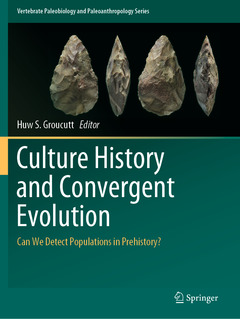Description
Culture History and Convergent Evolution, 1st ed. 2020
Can We Detect Populations in Prehistory?
Vertebrate Paleobiology and Paleoanthropology Series
Coordinator: Groucutt Huw S.
Language: English
Subjects for Culture History and Convergent Evolution:
Publication date: 07-2021
302 p. · 21x27.9 cm · Paperback
Publication date: 07-2020
302 p. · 21x27.9 cm · Hardback
Description
/li>Contents
/li>Biography
/li>Comment
/li>
This volume brings together diverse contributions from leading archaeologists and paleoanthropologists, covering various spatial and temporal periods to distinguish convergent evolution from cultural transmission in order to see if we can discover ancient human populations. With a focus on lithic technology, the book analyzes ancient materials and cultures to systematically explore the theoretical and physical aspects of culture, convergence, and populations in human evolution and prehistory. The book will be of interest to academics, students and researchers in archaeology, paleoanthropology, genetics, and paleontology. The book begins by addressing early prehistory, discussing the convergent evolution of behaviors and the diverse ecological conditions driving the success of different evolutionary paths. Chapters discuss these topics and technology in the context of the Lower Paleolithic/Earlier Stone age and Middle Paleolithic/Middle Stone Age. The book then moves towards a focus on the prehistory of our species over the last 40,000 years. Topics covered include the human evolutionary and dispersal consequences of the Middle-Upper Paleolithic Transition in Western Eurasia. Readers will also learn about the cultural convergences, and divergences, that occurred during the Terminal Pleistocene and Holocene, such as the budding of human societies in the Americas. The book concludes by integrating these various perspectives and theories, and explores different methods of analysis to link technological developments and cultural convergence.
Dr. Huw S. Groucutt is group leader of the Max Planck ‘Extreme Events Research Group’ in Jena, Germany. He received his Bachelors in Archaeology and Masters in Paleoanthropology at the University of Sheffield in 2007 and 2008 respectively, and his PhD in Archaeological Science at the University of Oxford in 2013. He was then a postdoctoral researcher on the ERC funded Palaeodeserts project (2013-2016) and then a British Academy postdoctoral fellow (2016-2019), both at the University of Oxford. He has co-written over 50 journal articles, and co-edited four books and journal special issues. Dr Groucutt's research interests include human evolution and prehistory, stone tool technologies, human demographic changes in the Saharo-Arabian belt, and the relationship between hominin demography and environmental change.
Covers various spatial and temporal periods to explore how to distinguish convergent evolution from cultural transmission
Determines how to detect ancient populations by analyzing material cultures and comparing them to lithic data
Draws on diverse contributions from leading archaeologists and palaeoanthropologists




